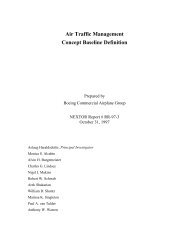Capacity Coverage Charts Workbook - Center for Air Transportation ...
Capacity Coverage Charts Workbook - Center for Air Transportation ...
Capacity Coverage Charts Workbook - Center for Air Transportation ...
Create successful ePaper yourself
Turn your PDF publications into a flip-book with our unique Google optimized e-Paper software.
George Mason University<strong>Center</strong> <strong>for</strong> <strong>Air</strong> <strong>Transportation</strong> Systems Researchhttp://catsr.ite.gmu.eduUnit: <strong>Capacity</strong> of Runway Systems3) Draw a CCC using the data in the table below. Label axes.Movement perHour% Time Runway Config ArrivalRunwaysDepartureRunways132 60 1 4R, 4L 4R, 4L, 09120 18 9 22L, 27 22R, 22L98 10 1082 2 1160 2 245 5 2a, 7, 12, 15, 340 3 3, 3a, 163-1) What percentage of time does the airport support 132 movements________________________________________________________________________________________________________________________________________________3-2) What percentage of time does the airport support at least 60 movements________________________________________________________________________________________________________________________________________________3-3) If capacity limits at the airport are used to limit the scheduled arrival s anddepartures to 132 movements per hour:SYST460/560 – Fall 2009Instructor: Dr. Lance Sherry, lsherry@gmu.edu2
George Mason University<strong>Center</strong> <strong>for</strong> <strong>Air</strong> <strong>Transportation</strong> Systems Researchhttp://catsr.ite.gmu.eduUnit: <strong>Capacity</strong> of Runway Systemsa) What percentage of time will flights experience delays________________________________________________________________________b) What percentage of time will the runways go unused________________________________________________________________________c) On average, how many flights will experience delays________________________________________________________________________3-4) If capacity limits are used to limit the scheduled arrival s and departures to 60movements per hour:a) What percentage of time will flights experience delays________________________________________________________________________b) What percentage of time will the runways go unused________________________________________________________________________c) On average, how many flights will experience delays________________________________________________________________________d) On average, how many movement slots will go unused________________________________________________________________________e) What is best <strong>for</strong> the airlines, to over-schedule and have delays, or to underscheduleand have no delays but unused capacity. Explain.________________________________________________________________________________________________________________________________________________SYST460/560 – Fall 2009Instructor: Dr. Lance Sherry, lsherry@gmu.edu3
George Mason University<strong>Center</strong> <strong>for</strong> <strong>Air</strong> <strong>Transportation</strong> Systems Researchhttp://catsr.ite.gmu.eduUnit: <strong>Capacity</strong> of Runway Systems________________________________________________________________________________________________________________________________________________4) Explain the difference between an airport with a “flat” CCC and an airport withan “Uneven” CCC in terms of utilization, flight delays and predictable per<strong>for</strong>mance.________________________________________________________________________________________________________________________________________________________________________________________________________________________________________________________________________________________________________________________________________________________________________________________________________________________________________________5) How should runways be configured to ensure a “flat” CCC at airport located in aregion with variable (direction) wind conditions________________________________________________________________________________________________________________________________________________________________________________________________________________________________________________________________________________________________________________________________________________________________________SYST460/560 – Fall 2009Instructor: Dr. Lance Sherry, lsherry@gmu.edu4
George Mason University<strong>Center</strong> <strong>for</strong> <strong>Air</strong> <strong>Transportation</strong> Systems Researchhttp://catsr.ite.gmu.eduUnit: <strong>Capacity</strong> of Runway Systems________________________________________________________________________________________________________________________________________________SYST460/560 – Fall 2009Instructor: Dr. Lance Sherry, lsherry@gmu.edu5
















